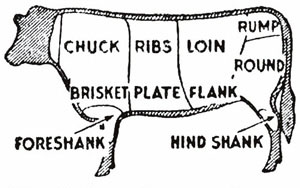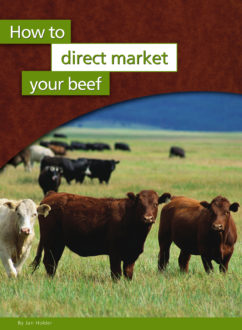
No doubt if you’re looking into direct marketing your own beef you’ve talked to a butcher about how a carcass is cut up, and how much of what cut you can expect from a carcass. If you have and walked away feeling totally mystified, join the club. There are a million ways to cut up a carcass. If that isn’t bad enough, different people call the same cuts by different names.
What’s the difference between a top sirloin and a T-bone? Or a Kansas City strip steak and a New York strip steak? Or a breakfast steak and a cube steak?
I even went in and watched them cut up the carcass, thinking it might help to visualize all this stuff. Actually, it did and I would recommend it highly. Even more, the biggest help to me was a book called The Beef Buyers Guide. This is a secret club kind of thing. Everybody in the industry pretends that this is a holy writ, but you won’t find it in a bookstore (although you can order it online). This book breaks down the carcass into different pages, tells you all the cuts you can make from a certain section and provides helpful pictures.
For instance, with the rib section you can make a rib steak/bone in/tail on, or rib steak/bone in/tail off, or boneless rib steak, or tied rib roast, and so on. It is a bit of overkill, but it will give you a working knowledge. Plus, it contains the codes that restaurants use, so you’ll know when someone calls and says he wants a 1139a (whole tenderloin, ¼-inch trim, lip on).
In actual practice, it turns out no one really knows all of those codes. There are regional differences in what meat people will call the same cut, both in name and in code (a New York strip and a Kansas City strip are the same thing). But if you know them, it will make you look smarter than the conventional meat salesperson.
As I mentioned, you can cut up a carcass many ways. It all depends how much, and of what, you are selling. If you’re just starting out and aren’t that sure of your quality, start with cull cows. They’ll give you excellent hamburger and store-quality tenderloin. The next step up is young cows and steers, which give you tenderloin, stew beef, marinated roasts, jerky and hamburgers. If you’re really good, you have the slaughter steer or heifer, which gives you everything.
As a rule of thumb, a 1,000-pound live animal will give you about 300 pounds of saleable beef or, in industry lingo, your “boxed weight.” You might hear people talk about getting 50 percent yields (versus your 30 percent). What they are talking about is the “cold carcass” weight, or how much your carcass weighs on the rail. This weight is meaningless; what counts is the weight of the beef you sell. If you are cutting steaks or making hamburger for people, there is a lot of bone you don’t get paid for.
Of course, you can divide a carcass into many different cuts (right), each of which contributes to your bottom line. Your actual weights may vary 5 percent each way depending upon your genetics and slaughter weight, but this is generally about average.
